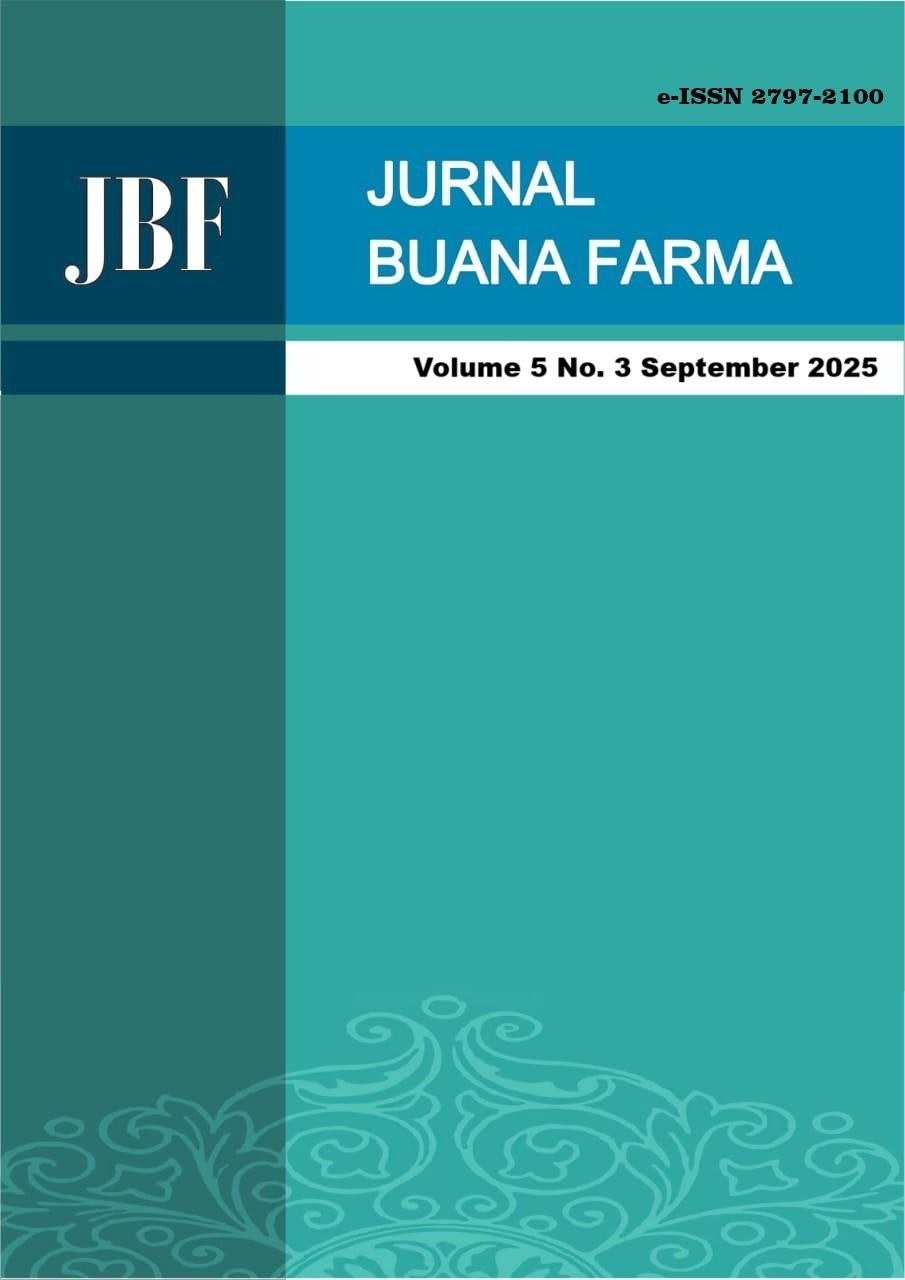UJI AKTIVITAS EKSTRAK ETANOL 50% AKAR GINSENG JAWA (Talinum paniculatum Jacq. (Gaert)) SEBAGAI INHIBITOR STRESS OKSIDATIF
Abstract
Oxidative stress is a condition in which an imbalance occurs between the production of free radicals and the body’s antioxidant defense system, potentially leading to various degenerative diseases. Java ginseng (Talinum paniculatum Jacq. (Gaertn)) is a medicinal plant known to contain bioactive compounds with free radical–reducing potential. This study aimed to identify the mechanism of nitric oxide (NO) inhibition through the decomposition of sodium nitroprusside in the Reactive Nitrogen Species (RNS) pathway and to evaluate the increase of catalase enzyme activity in the Reactive Oxygen Species (ROS) pathway using 50% ethanol extract of Java ginseng root. The root extract was obtained using Soxhlet extraction with 50% ethanol as the solvent, and five different extract concentrations were tested: 20, 40, 60, 80, and 100 μg/mL. Antioxidant activity was assessed by measuring the inhibition of NO radical formation and the enhancement of catalase activity, with vitamin C as a comparator. The ethanol extract of Java ginseng root inhibited NO radical formation with an IC50 value of 42.45 μg/mL, which is classified as a very strong antioxidant. In comparison, vitamin C showed an IC50 of 6.47 μg/mL, also categorized as very strong. Furthermore, the extract increased catalase activity proportionally to its concentration, although the effect was still lower than that of vitamin C. These results indicate that the 50% ethanol extract of Java ginseng root possesses significant potential as an oxidative stress inhibitor through NO inhibition and catalase activation, though its effectiveness remains lower than vitamin C.
References
Coelho, F. C., Tirloni, C. A. S., Marques, A. A. M., Gasparotto, F. M., Lívero, F. A. dos R., & Gasparotto Junior, A. (2019). Traditional Plants Used by Remaining Healers from the Region of Grande Dourados, Mato Grosso do Sul, Brazil. Journal of Religion and Health, 58(2):572–588. https://doi.org/10.1007/s10943-018-0713-0
Dos Reis, L. F. C., Cerdeira, C. D., De Paula, B. F., Silva, J. J. da, Coelho, L. F. L., Silva, M. A., Marques, V. B. B., Chavasco, J. K., & Alves-Da-Silva, G. (2015). Chemical Characterization and Evaluation of Antibacterial, Antifungal, Antimycobacterial, and Cytotoxic Activities of Talinum paniculatum. Revista Do Instituto de Medicina Tropical de Sao Paulo, 57(5):397–405. https://doi.org/10.1590/S0036-46652015000500005
Fauziah, A., Sudirga, S. K., & Parwanayoni, N. M. S. (2021). Uji Antioksidan Ekstrak Daun Tanaman Leunca (Solanum nigrum L.). Metamorfosa: Journal of Biological Sciences, 8(1):28. https://doi.org/10.24843/metamorfosa.2021.v08.i01.p03
Jomova, K., Raptova, R., Alomar, S. Y., Alwasel, S. H., Nepovimova, E., Kuca, K., & Valko, M. (2023). Reactive Oxygen Species, Toxicity, Oxidative Stress, And Antioxidants: Chronic Diseases And Aging. Archives of Toxicology, 97(10):2499–2574. https://doi.org/10.1007/s00204-023-03562-9
Kemenkes RI. (2020). Profil Kesehatan Indonesia 2020. https://doi.org/10.1080/09505438809526230
Mudigdo, A., Riyana, A., & Wasita, B. (2019). The Effects Of Ginseng Java Roots (Talinum Paniculatum) Extract On Malondialdehyde (Mda) Levels In Male White Sprague Dawley Rats With Forced Swimming Test Model. IOP Conference Series: Materials Science and Engineering, 546(6). https://doi.org/10.1088/1757899X/546/6/062025
Quintans-Júnior, L., Moreira, J. C. F., Pasquali, M. A. B., Rabie, S. M. S., Pires, A. S., Schröder, R., Rabelo, T. K., Santos, J. P. A., Lima, P. S. S., Cavalcanti, S. C. H., Araújo, A. A. S., Quintans, J. S. S., & Gelain, D. P. (2013). Antinociceptive Activity and Redox Profile of the Monoterpenes (+)-Camphene, p -Cymene, and Geranyl Acetate in Experimental Models . ISRN Toxicology:1–11.
https://doi.org/10.1155/2013/459530
Reddy, V. P. (2023). Oxidative Stress in Health and Disease. Biomedicines, 11(11). https://doi.org/10.3390/biomedicines11112925
Tourabi, M., Faiz, K., Ezzouggari, R., Louasté, B., Merzouki, M., Dauelbait, M., Bourhia, M., Almaary, K. S., Siddique, F., Lyoussi, B., & Derwich, E. (2025). Optimization of extraction process and solvent polarities to enhance the recovery of phytochemical compounds, nutritional content, and biofunctional properties of Mentha longifolia L. extracts. Bioresources and Bioprocessing, 12(1), 24. https://doi.org/10.1186/s40643-025-00859-8
Zhang, Q.-W., Lin, L.-G., & Ye, W.-C. (2018). Techniques for extraction and isolation of natural products: a comprehensive review. Chinese Medicine, 13(1), 20. https://doi.org/10.1186/s13020-018-0177-x













